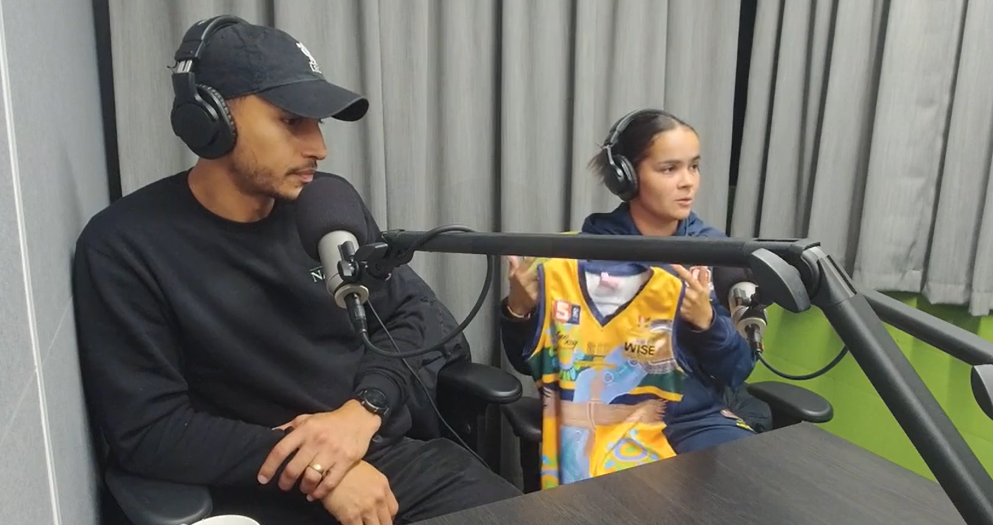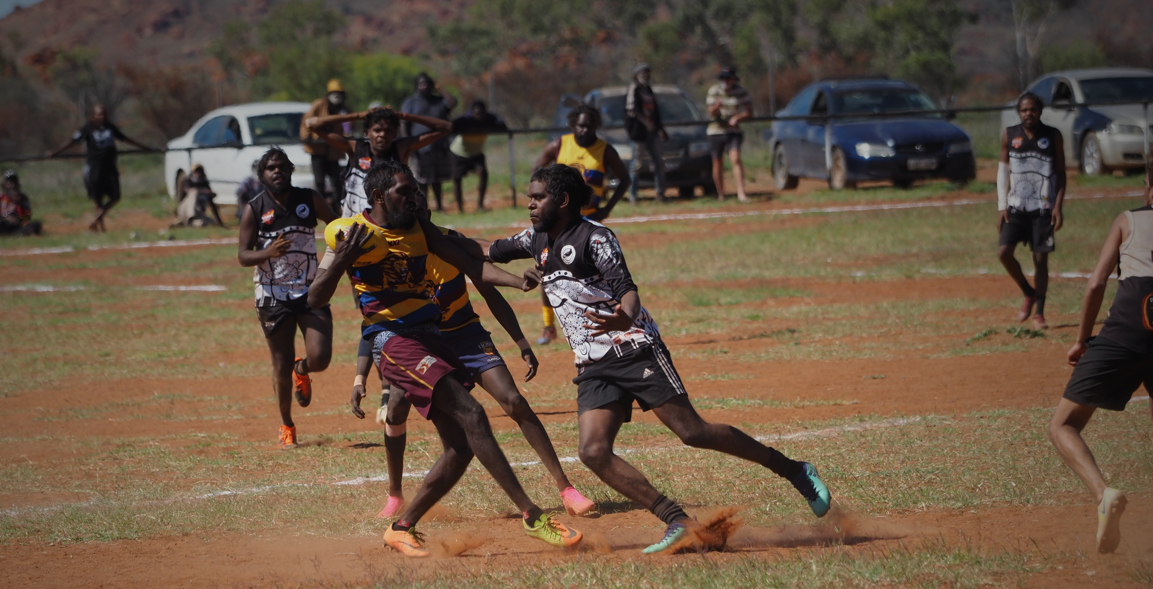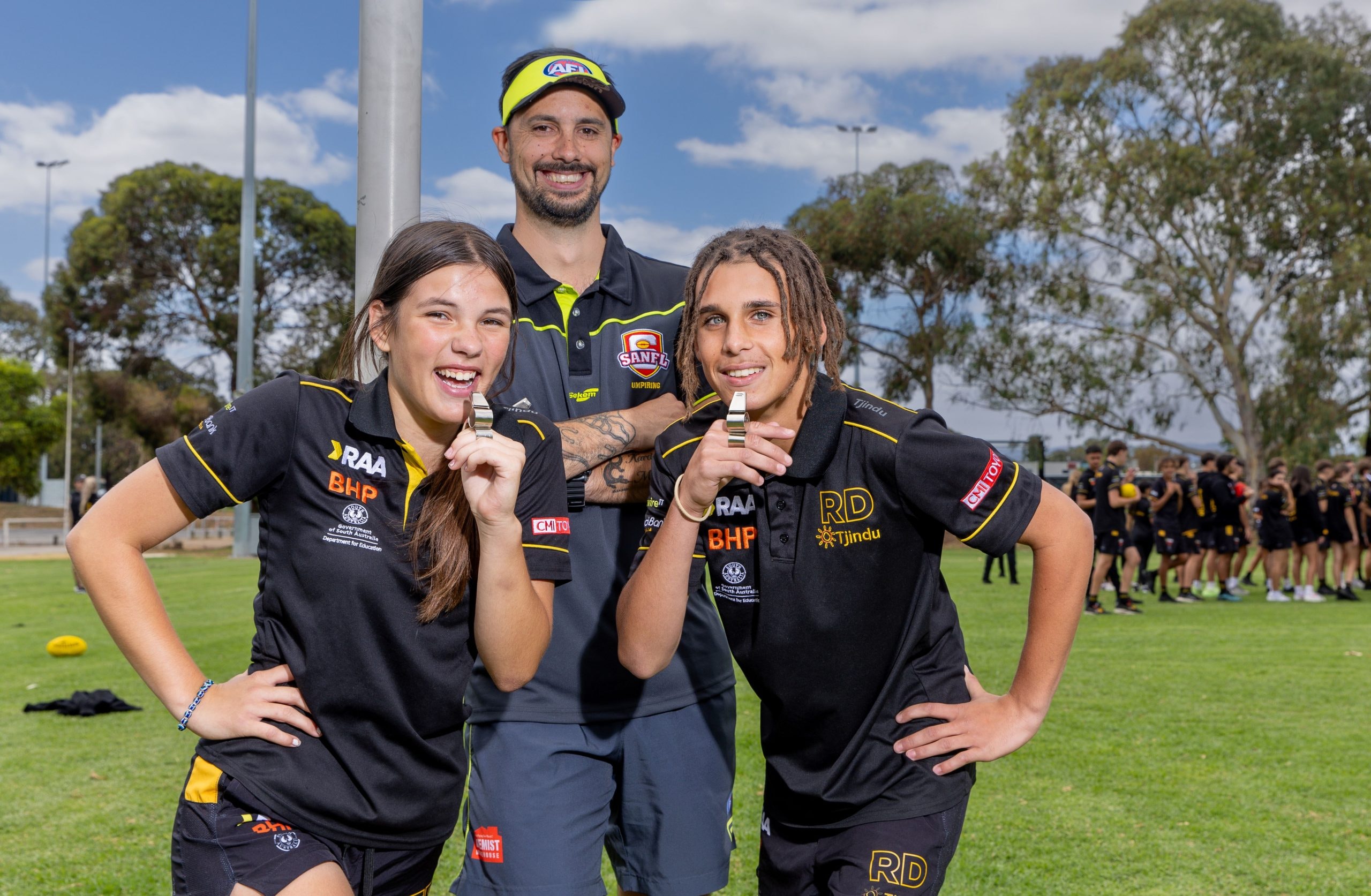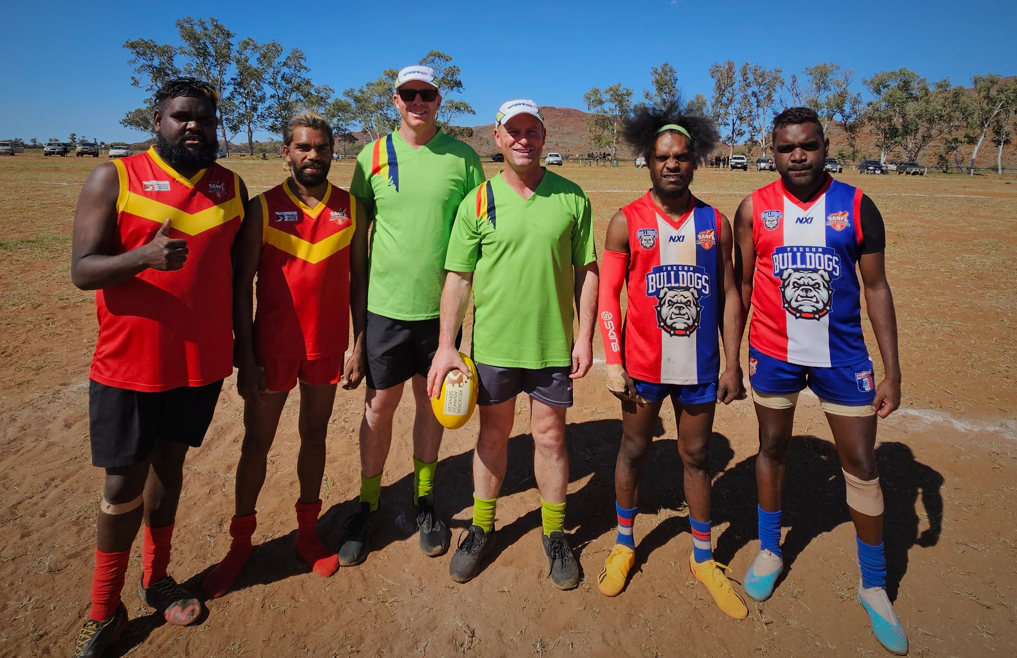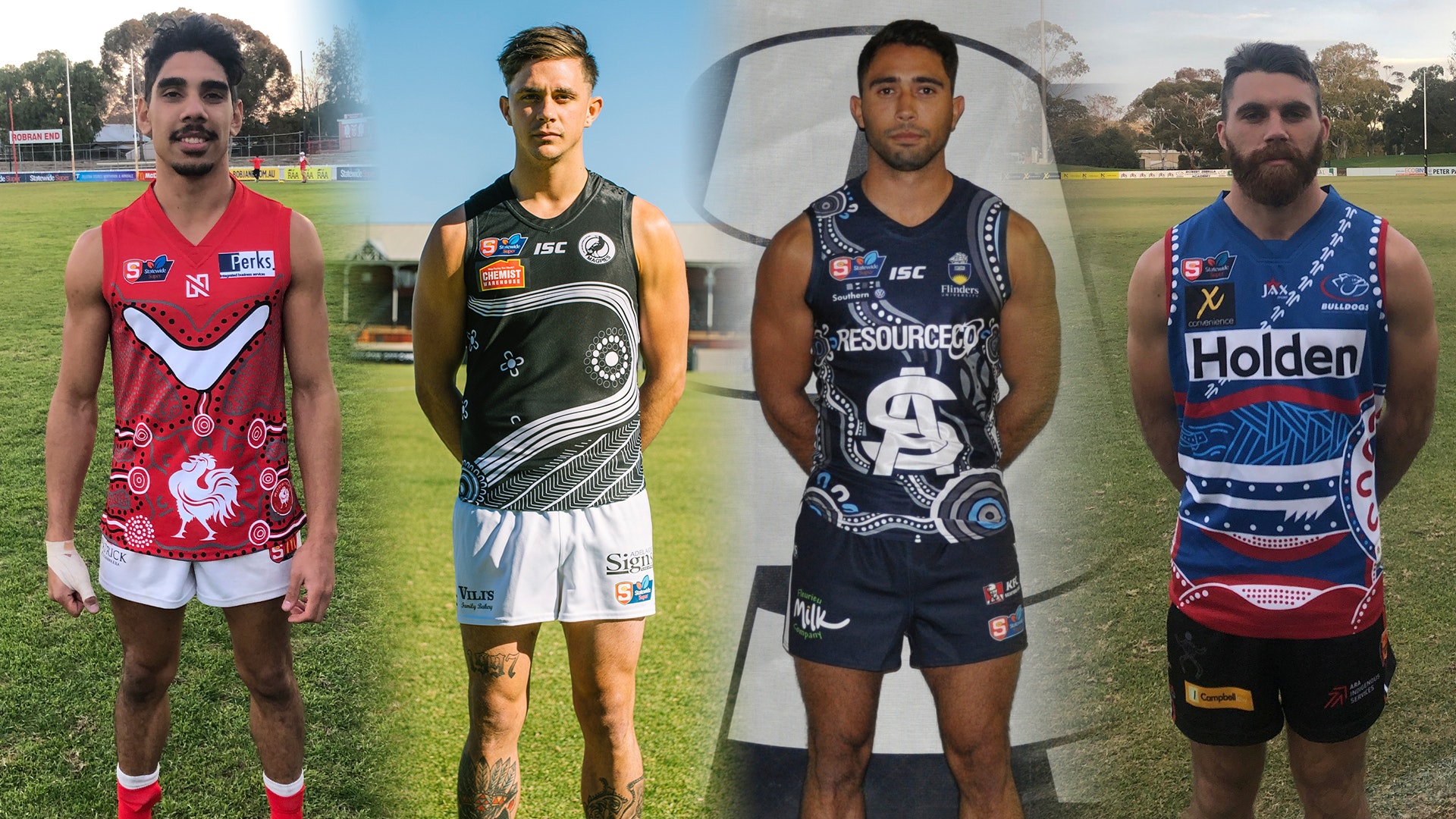
SANFL Indigenous Round Guernseys
SANFL is celebrating the wonderful contribution Aboriginal and Torres Strait Islander players have, and continue to, make in the Statewide Super League through Indigenous Round.
A welcome to country will be performed before all Round 13 matches to recognise Indigenous people as the first custodians of the land.
ZAC MILBANK has compiled all of the specially-designed Indigenous Round guernseys which will be worn by all 10 SANFL teams this weekend.
Adelaide
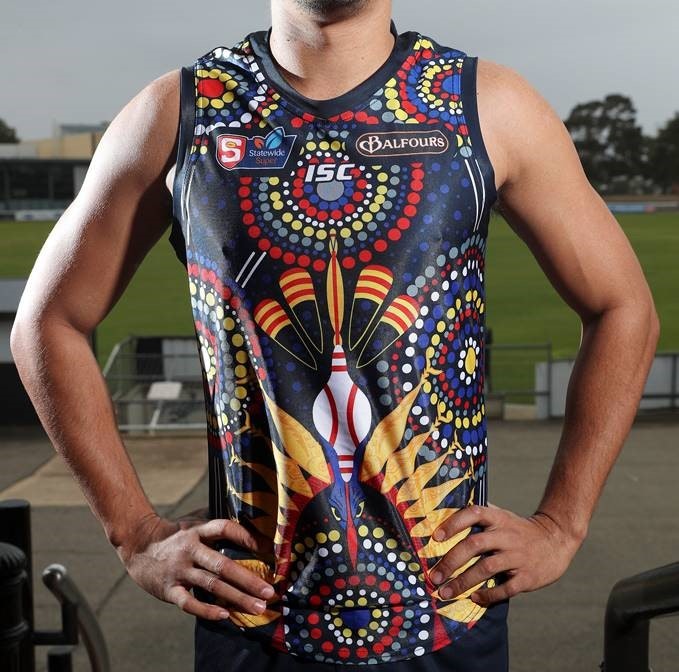
Designed by Crows legend Andrew McLeod and his brother Jonathan, Adelaide’s Indigenous guernsey pays tribute to their Torres Strait Islander culture through nine different elements.
1. Koedal – the Crocodile tail depicts a strong powerful ancient totem (McLeod’s totem)
2. Cod fish – part of an Islanders’ staple diet taken from the reef to feed families
3. Rope made from coconut fibres – are closely knitted and entwined to be strong, similar to our relationships with each other and our environment
4. Spiral shells – are found on our beaches everywhere reminding us of home
5. Decorative ornamental shells – strikingly decorative and found on our reefs
6. Long Bum – found in the mangroves are a source of food and good to eat
7. Waru – a turtle laying its eggs on the beach symbolises new life, survival and is also an important food source
8. Warup – an Island Drum with a booming sound like the clapping of thunder is used in song and dance and resonates with an Islanders heart
9. Dhangal – Dugong, this is also a totem and an important food source, the picture shows how they are cut up for kai kai (eating)
Central District
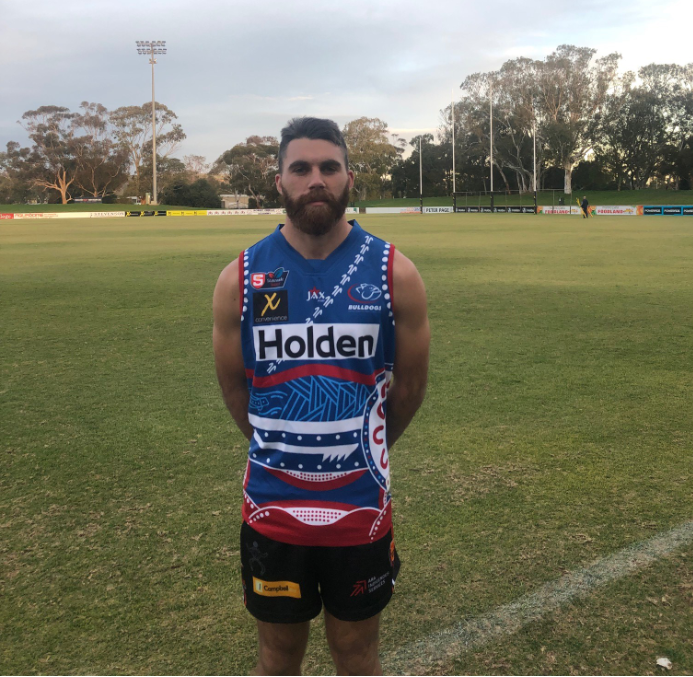
Central’s Isaya McKenzie models his club’s Indigenous Round guernsey.
Designed by senior player Isaya McKenzie with assistance from Brenton Watts.
From Top of the Guernsey to the Bottom
Kangaroo Footprints – The kangaroo footprints jumping across the chest, this represents the Kaurna people on which land we play football on.
The Blue – Represents Brenton Watts (Senior player of CDFC) mob (Alawa and Mara mob from the Northern Territory). The fish is a barramundi and the lines are a traditional pattern from Brenton’s culture.
The spear and dots – The spear is the spear from the Ngarrindjeri flag and the dots represent the 18 tribes that make up the Ngarrindjeri nation. This is the story of Ari Rigney (Senior player for CDFC) Mob and his cultural background.
Kaurna shield – The next is a traditional Kaurna shield pattern, this is a show of respect to the Kaurna people to which land we play on at CDFC.
Hills – The hills represent the Adnyamathanha people, the cultural background of Isaya McKenzie (Senior player of CDFC). Adnyamathanha means rock people and their land is located in the Northern Flinders Rangers area, the hills represent the Flinders Rangers.
All the different mobs in the design represent a senior indigenous player and their journey on how they come to be at the club today.
Circle design on side: Dots on the outside represent the community and supporters, the next pattern represents the coaching staff and the officials of CDFC. The centre is an aboriginal shield, represents the players going to battle together on the footy field.
Glenelg
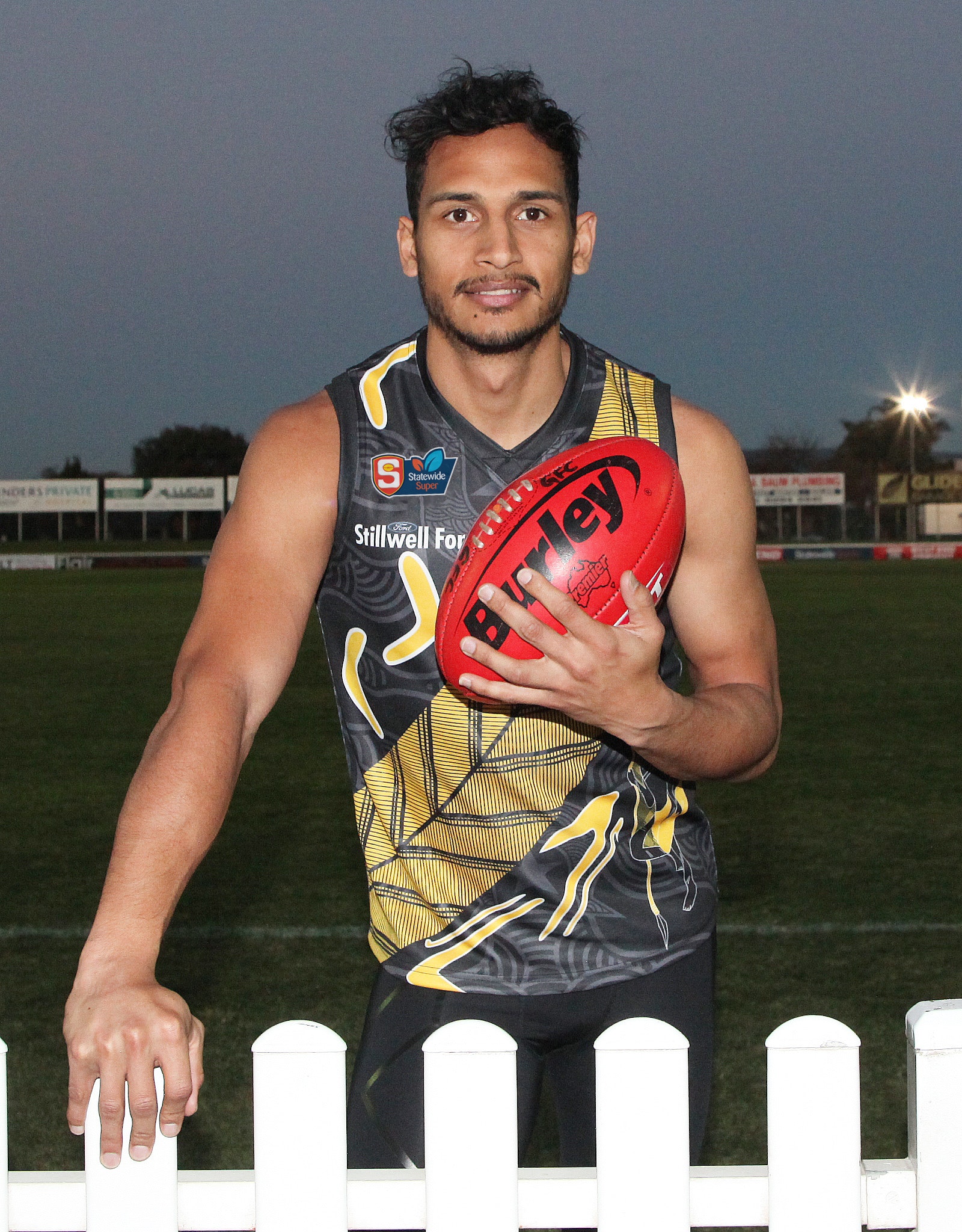
Glenelg’s Marlon Motlop wears his specially-designed Indigenous Round guernsey. Picture – Peter Argent.
Design – titled ”Stand Strong” – is by Glenelg senior player Marlon Motlop and his cousin Keelan Fejo.
“The Aboriginal man is holding his spear and shield which represents him standing strong in war (battle) – this can reflect how we are when we play the game, for most of us it’s like going to battle,” Motlop said.
“The cross-hatching (Rarrkbun) represents the direction of strength, power and knowledge when the spear is being thrown.
“Boomerangs represent stories and songs – this reflects a connection to footy and how many of these great stories and songs come out of the game and stay with us forever.
“The weapons are tools which represent the effort we give to get to where we are now and the under-layer design is the Torres Strait Islander head dress “Dhoeri”, which is a representation of Torres Strait Islander people.
“The patterns and streams in the under-layer represent the wind direction of the Torres Strait.”
North Adelaide
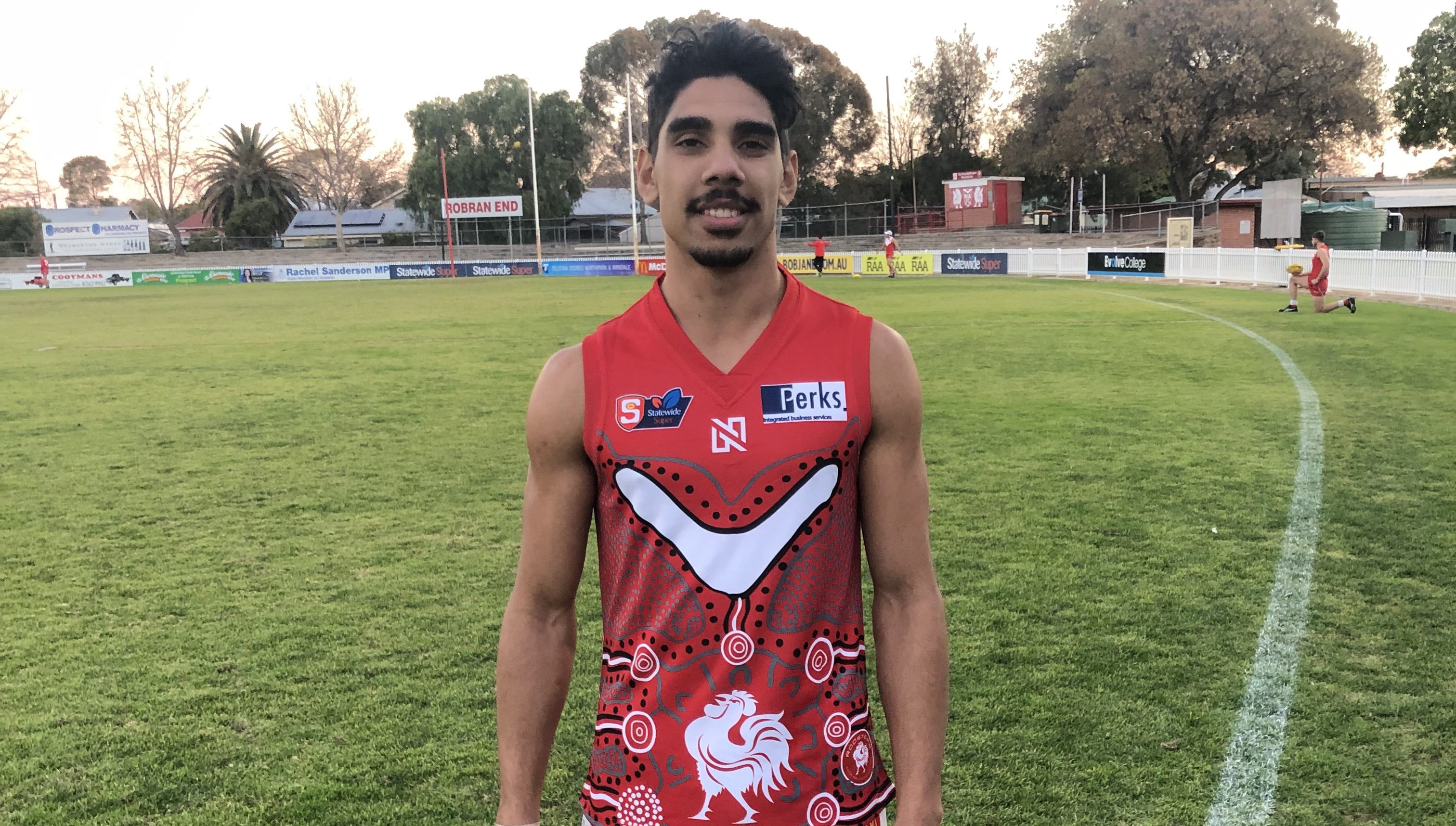
North Adelaide’s Keanu Miller wearing the Roosters’ Indigenous Round guernsey.

Designed by North Adelaide forward Keanu Miller.
Front of guernsey – There’s a boomerang, on the outside of the boomerang is whale tale. The meaning for the whale tale is that it’s my grandfather’s dreaming. There’s also six circles that represent the six North Adelaide indigenous players, and the dotted circle represents all of the senior players at the club.
Back of guernsey – There’s a fish on the bottom which is my grandmother’s dreaming, The lines coming from the circles on the front of the guernsey are making their way to the big circles on the back. It also reflects all the players’ journey to the club and to come together as a team.
Norwood
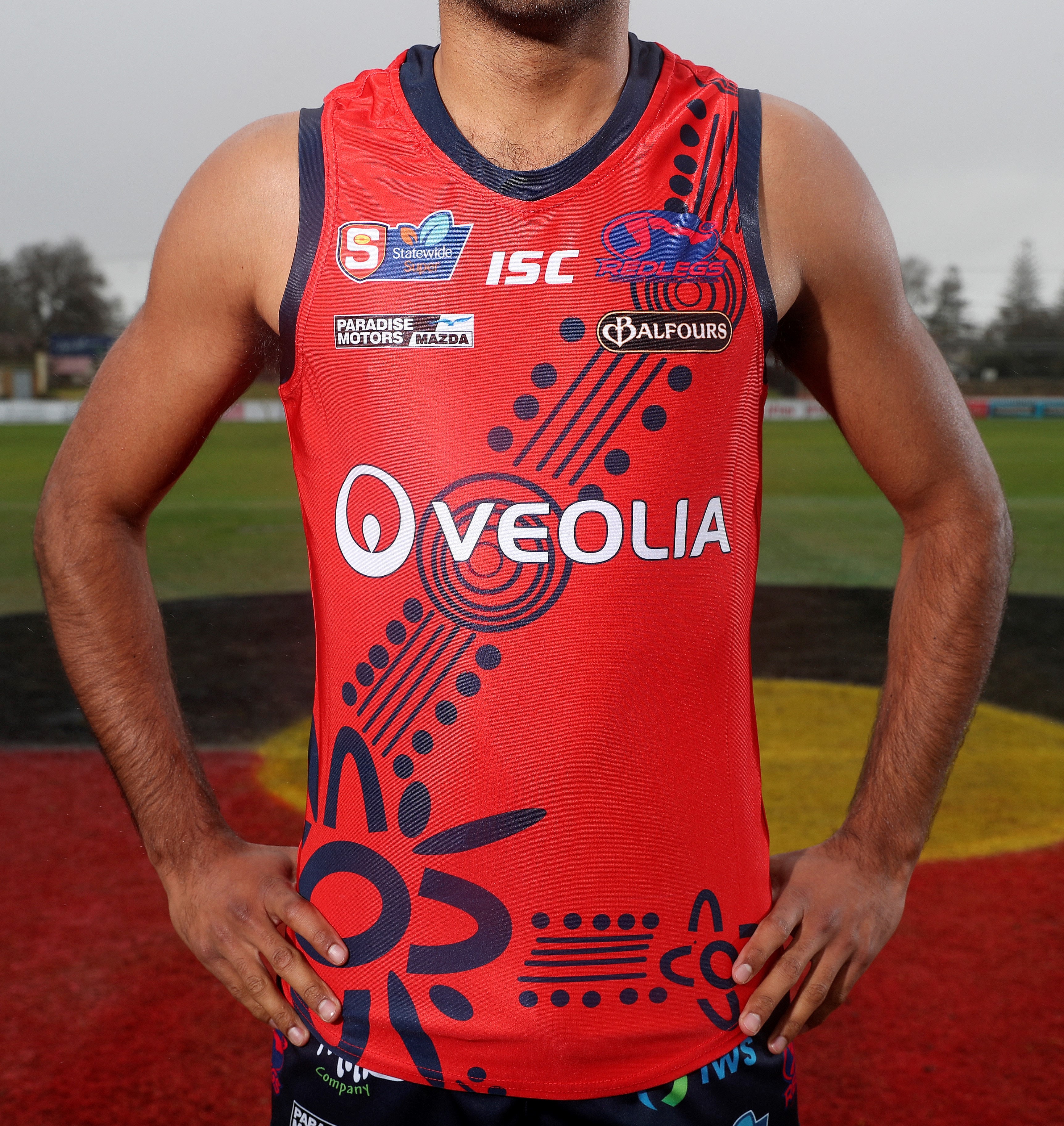
Designed by Kelly Carbine, a proud Wirangu Kookatha woman from Port Lincoln South Australia, who said she felt privileged to create the Redlegs’ 2019 Indigenous guernsey.
The guernsey pays homage to the country we live on and how different communities come together to connect, share and teach younger generations Aboriginal culture.
“I’m a strong believer in our younger generation learning from our elders, the stories they have been told to keep the Aboriginal Culture alive amongst our people,” Kelly said.
”This is why it meant a lot to me to design this Indigenous Guernsey, as I was able to show the story of the teaching, connection and closeness the different Aboriginal clans have throughout the country.”
The large emblem on the back represents a large gathering of people, this is an important emblem because it shows the circle of strength and connection.
The bigger half circle shapes represent people from different parts of the country coming together to teach the small half circles which represent the younger generation.
The dots and lines represent the desert, grass and sea areas connecting and coming together.
Port Adelaide
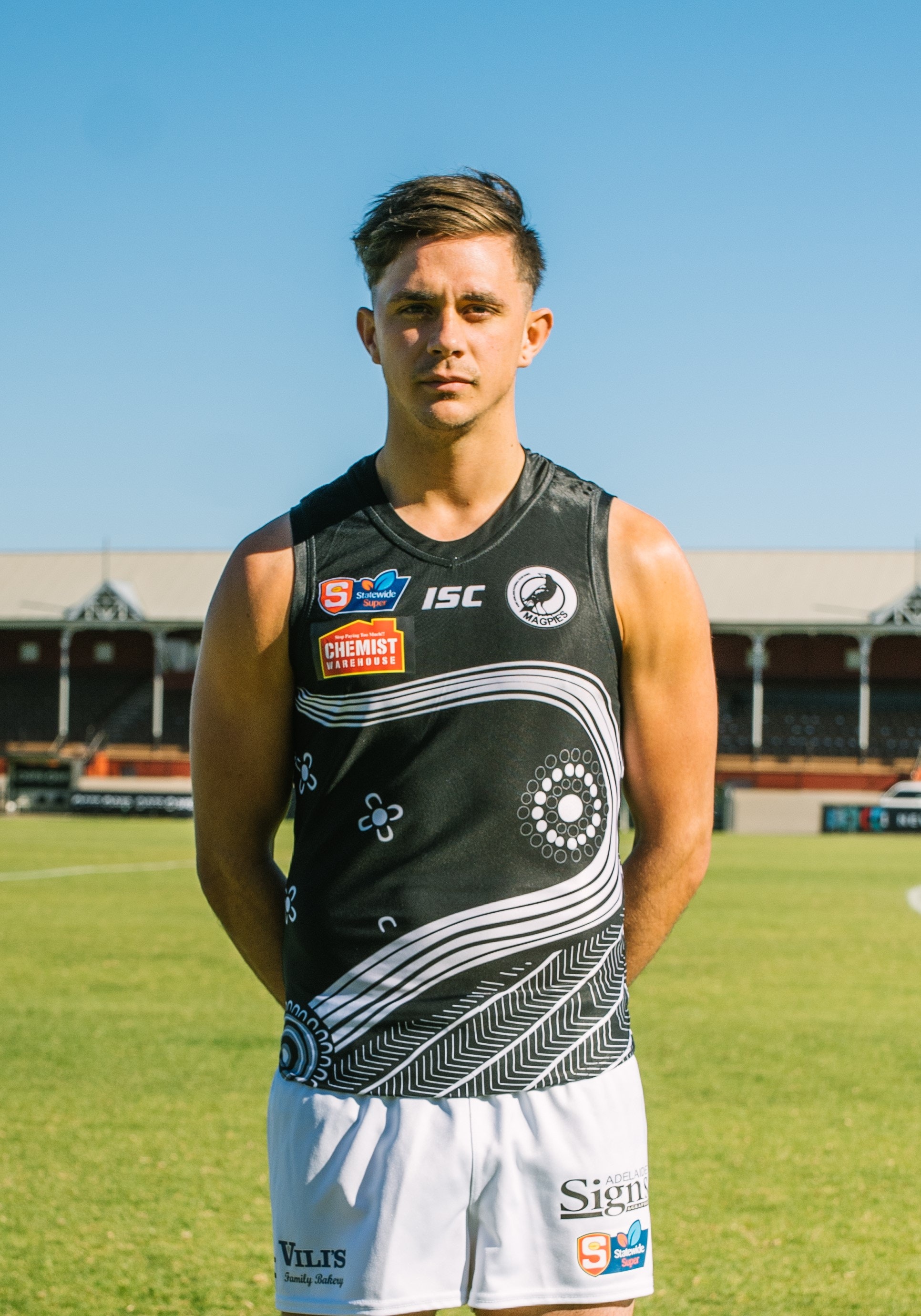
Port Adelaide’s SANFL Indigenous Round guernsey worn by Aidyn Johnson.
Designed by Port Adelaide midfielder Sam Powell-Pepper, who is a proud Wadjuk & Ballardong man, with the guernsey being a representation of his journey from Western Australia to Alberton.
”On the left of the guernsey are the 16 Indigenous players and staff that we have at Port Adelaide,” Powell-Pepper said.
“Here on the heart we have the 46 players – us boys, the brothers, on the heart.
“The bottom left circle represents Alberton Oval, our heartland, where all players and staff come together to support our dream.”
Powell-Pepper explained the meaning behind the bottom part of the guernsey, and the impact the members and fans have on the entire football club.
“We have the steps and the journey of all our members and fans,” he said.
“We are always wanting to pay respect to the people who support us through thick and thin.”
South Adelaide
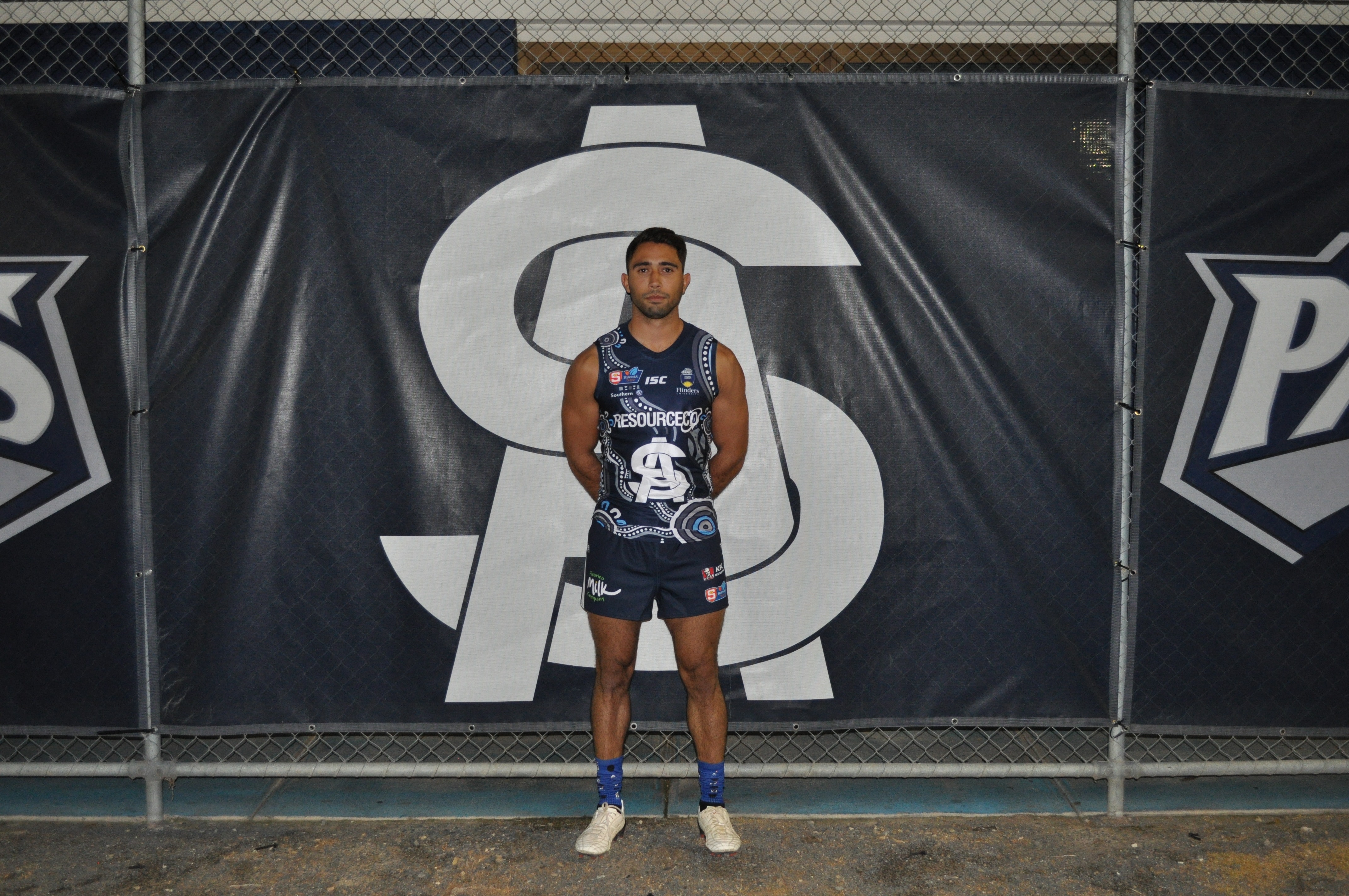
South Adelaide’s Malcolm Karpany wears the Panthers’ specially-designed Indigenous Round guernsey.
Allan Sumner, the designer of the guernsey has captured the essence of how the Panthers connect to the southern zone.
Sumner is a southern Indigenous artist and teaches Cultural Safety as part of the Poche Centre for Indigenous Health at Flinders University.
Acting Vice-Chancellor of Flinders University, Professor Clare Pollock said that the university is thrilled to have supported this initiative.
“There are many ways in which we can recognise, value and celebrate Aboriginal and Torres Strait Islander people’s culture, including in the sporting arena. As part of our partnership with The Panthers, we’re delighted to be supporting the Indigenous round match with this specially designed guernsey. It’s not just beautiful, but demonstrates how valuable sport can be in sharing knowledge and understanding and promoting reconciliation.”
The name that was given to this artwork is ‘Nurlungga’ or River Bend.
Being situated in Noarlunga, the Kaurna spelling Nurlungga derives from the word “Nurlu” meaning a corner or curvature referring to the nearby Onkaparinga River.
The lines bending around the top left shoulder and the right abdominal area represents the Onkaparinga River.
The large circle on the bottom left represents SAFC and the smaller circles represent the players who come from different communities connecting the club and player together.
Combined with the Kaurna Shield, the overall artwork brings together both the strength of SAFC and the spirit of the land.
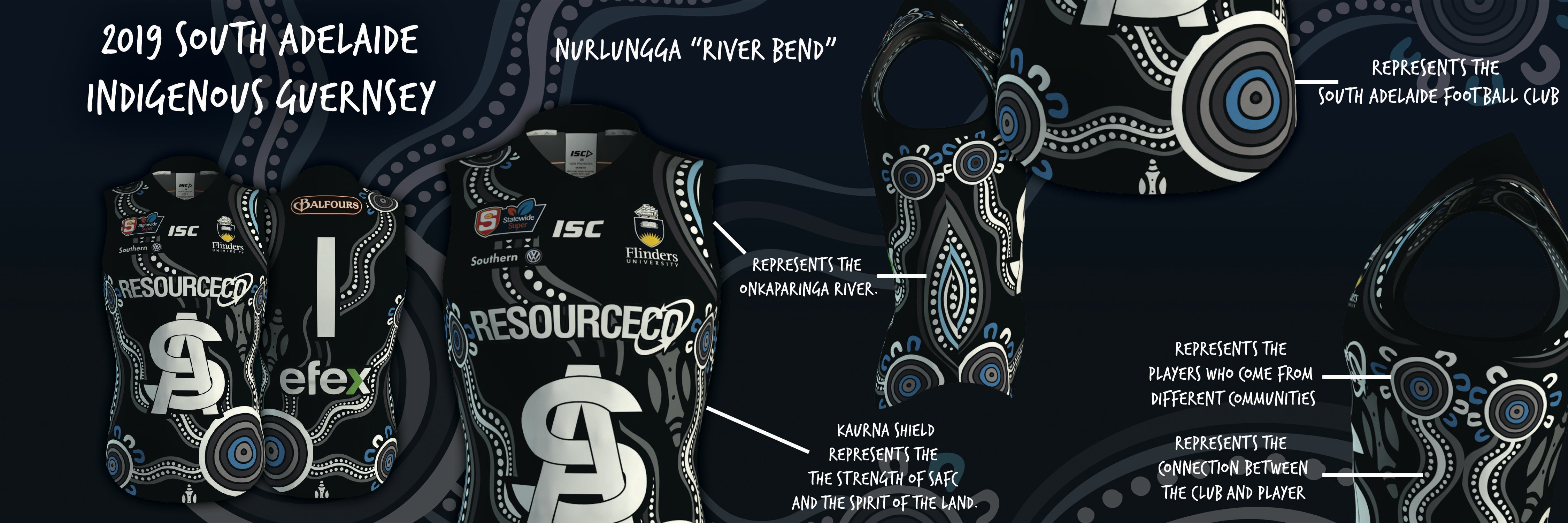
Sturt

Designed by Sturt premiership defender Byron Sumner in conjunction with Double Blues star Danyle Pearce, who provided the inspiration.
On the front, the design represents the River Murray flows joining people and communities across the land.
On the back is a watering hole which represents the Sturt Football Club and its people coming together as one.
West Adelaide

West Adelaide players Ken Karpany (left) and Gibson Turner wear the club’s 2019 Indigenous Round guernsey. Picture – Peter Argent
Designed by West Adelaide indigenous players Ken Karpany, Gibson Turner and the recently retired Zac Bates.
”When you look at the front of the jumper, on the sash is a traditional shield which represents the team doing its best to defend the West Adelaide Football Club,” Karpany said.
“There are also three men with spears showing the three of us are hunters and willing to fight for the guernsey.
“The circles represent each of the three of us and our journeys to this point. That’s why there is three of them on the back and the dots join us together as we come to the club and play for the West Adelaide jumper. This design is a story of everyone coming together to fight and defend the football club. We will wear the jumpers with plenty of pride.”
Woodville-West Torrens
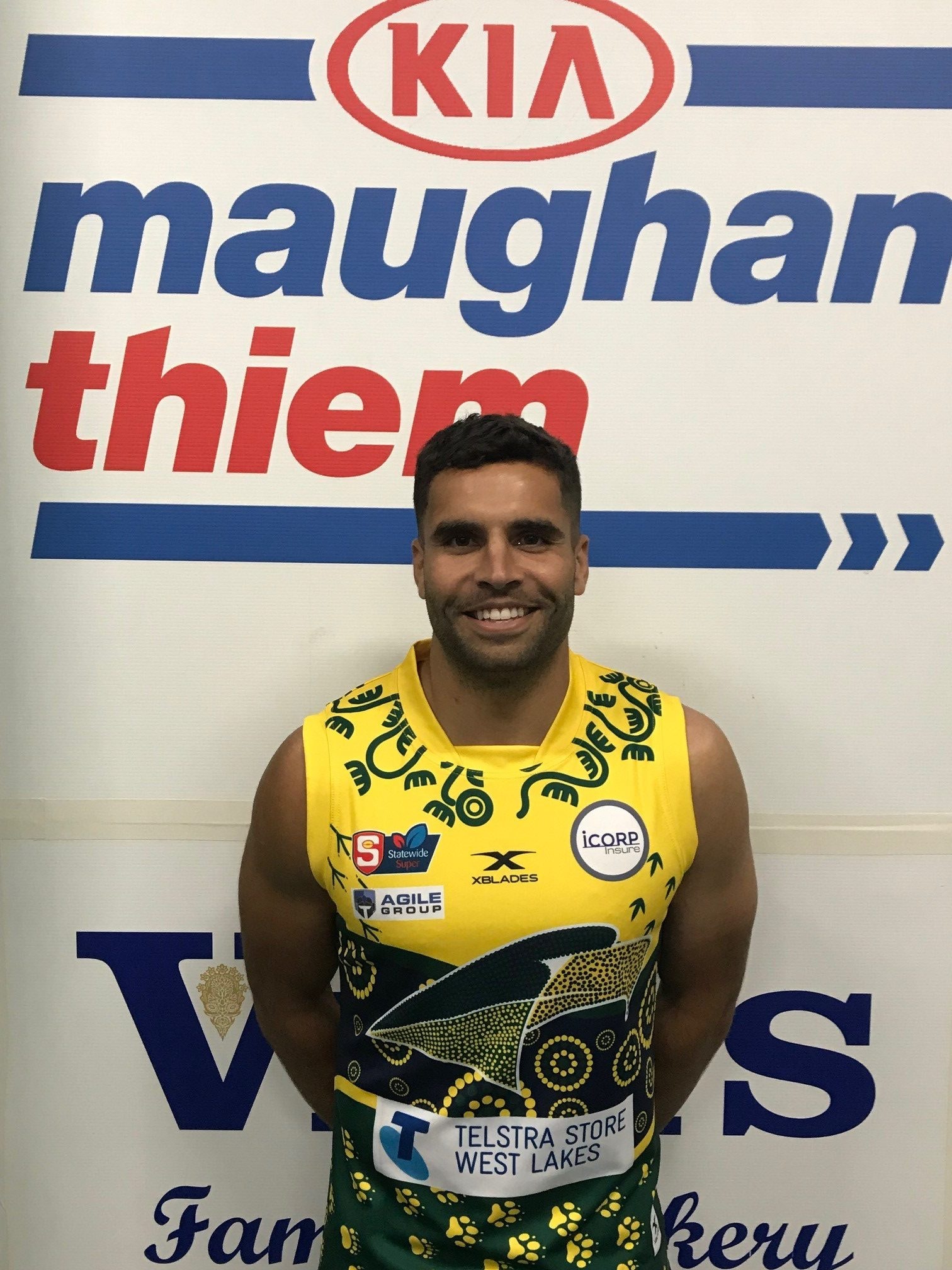
Eagles star Jared Petrenko wears the club’s 2019 Indigenous Round guernsey
The 2019 Woodville-West Torrens Indigenous Round guernsey was designed by Trevor and Cameron Buzzacott, proud Arabanna men.
The story reflects the many Indigenous men and women who play for the Eagles.
“We acknowledge and respect the Eagles value the importance of creating awareness and encouraging connections with Indigenous culture and heritage.
The young Indigenous footballers who play for Woodville-West Torrens (represented by the animal footprints) are the strong role models who are travelling as one to facilitate and educate the SANFL community on the history of the Indigenous culture and the importance it plays in Australia’s history.”
Related News
-
 First Nations
First NationsStrong SANFL connection at 2025 AFL Indigenous All-Stars match
-
 First Nations
First NationsSANFL Juniors to celebrate NAIDOC Week with First Nations Round
-
 Checkside Chats
Checkside ChatsCheckside Chats with Marlon Motlop and Channi Mitchell
-
 First Nations
First Nations2024 First Nations Round Guernsey Designs
-
 First Nations
First NationsThe People’s Champion – Sonny Morey
-
 First Nations
First Nations2024 SANFL APY League ready for kickoff
-
 Umpiring
UmpiringSANFL launches groundbreaking Indigenous Umpiring Program
-
 Community Footy
Community FootyAn ”unreal” experience for SANFL premiership greats



